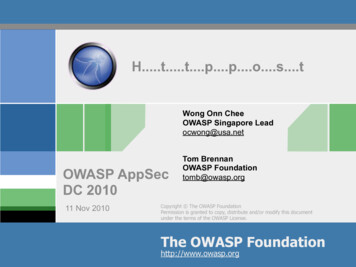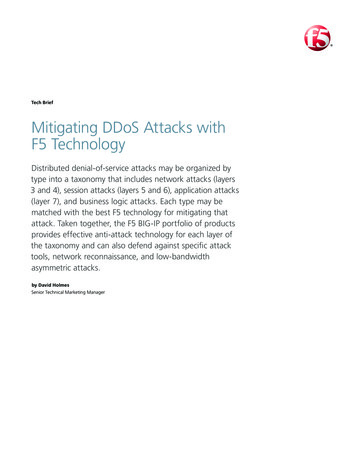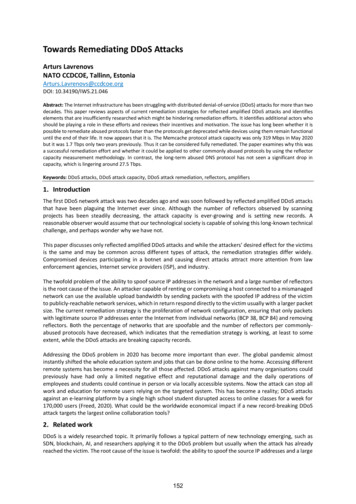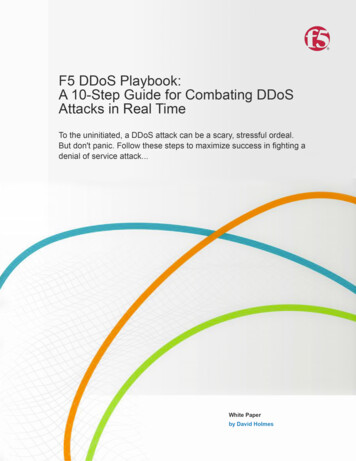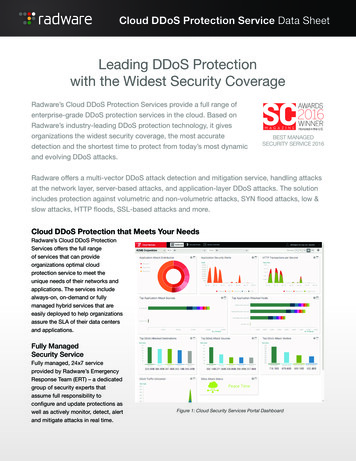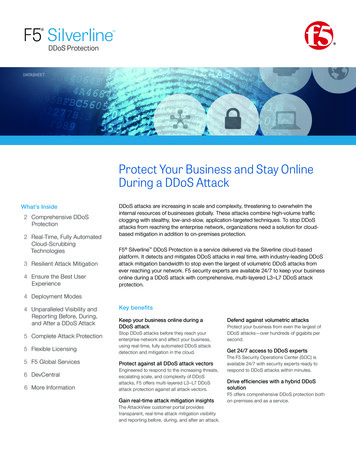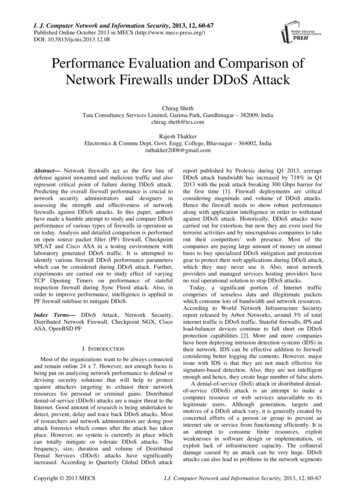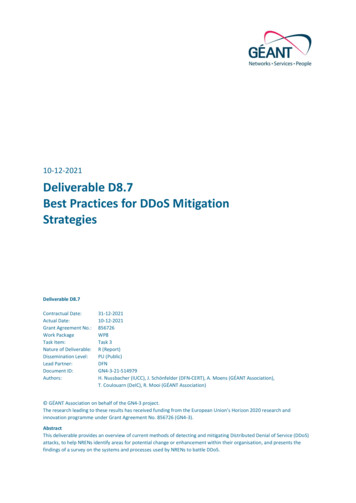
Transcription
Mitigating DDoSAttacks at Layer 7Detect, Localize andMitigate using DNS GSLBAllan JudeScaleEngine Inc.
IntroductionsAllan Jude 12 Years as FreeBSD Server AdminArchitect of the ScaleEngine CDN (HTTP and Video)Host of BSDNow.tv & TechSNAP.tv PodcastsFormer Professor @ Mohawk College (2008-2011)teaching Network Engineering and Security Analysis Extensive work with Puppet to manage our 80 oddservers in 28 data centers in 10 countries Lots of work with ZFS to manage large collections ofvideos as well as extremely large website caches (15 million objects in ff*ff directories)
HistoryFrom 2002 - 2012 I ran an IRC shell provider,specializing in hosting smallish IRC networksas well as some protection bots and BNCs(proxies)During this time my servers were subject tonumerous different types and sizes of DDoSattacks and other attempts to disrupt services(take down IRC servers, gain control of roomson EFNet etc)
Overview DDoS Attack TypesDefensive TechniquesCommercial SolutionsUsing a GSLB to Localize andMitigate Implementation Examples Where to go from here
What Is Distributed Denial of Service "A Denial of Service attack (DoS) is anyintended attempt to prevent legitimate usersfrom reaching a specific network resource."[1] [1] Protection against Denial of Service Attacks: A Survey - http://staffweb.cms.gre.ac.uk/ l.pdf
Types of DDoS Volumetric / Link Saturation (Bandwidth)Protocol Attacks (SYN flood, fragments)Packet Storm (Excessive PPS)Resource Starvation (CPU, I/O, Memory)Stealth/Creeper (Slowloris, Slow POST)Exploit (Application or OS Specific DoS)DoS L2 - Intentionally trigger defensivemechanisms to block traffic from the(spoofed) source address or subnet
Statistics Average attack lasts 34.5 hours China is #1 origin of DDoS traffic, making up40-50% of all botnet activity 75% of attacks are against Infrastructure(layers 3 & 4, SYN Flood, ICMP/UDP attack)with only 25% against Applications (layer 7) 25% of all attacks are under 1 gbps, and50% of all attacks are under 6 gbps[Source] Prolexic Quarterly Global DDoS Attack Report 2013Q1 - attack report q113 englishversion/Prolexic Quarterly Global DDoS Attack Report Q113 041613.pdf
Planning .
Defensive Techniques Simple FailoverNull Route (Automated or Manual)Web Application FirewallAnycastProactive Name servers (a service from yourregistrar that provides failover to additionalname servers, especially useful in the eventof a DDoS against your name servers) Commercial Solutions
Simple Failover (Hidden Spares) When a machine or location is under attack,fail over to another machine/location Works better in Active/Passive mode,because in Active/Active the attacker mayattack both locations If you have a sufficient number of hiddenspares, you may be able to evade theattacker for a while
Null Route (Blackhole) You or your provider send /32 routesupstream, routers stop forwarding the attack(and all other) traffic to you, preventing thesaturation of your link This allows traffic to adjacent machines orcustomers that are not under attack tocontinue normally Some providers implement this automaticallyto lessen the disruption of a single customerbeing attacked
Web Application Firewall Only protect against specific known attacks Actually meant to prevent intrusions andexploits, rather than brute force attacks Are often a bottleneck or failure pointbecause they can handle only very limitedpackets-per-second and often haveunderpowered CPUs, can actually amplifythe attack and take you down sooner Usually subject to limits on the number ofconcurrent sessions/connections or otherscalability issues
Anycast Announce BGP routes for a single prefixfrom multiple locations Traffic is directed based on fewest hops Automatically distributes traffic betweenlocations based on source network Limits damage caused by DDoS attacks tothe areas nearest the attackers Requires your own IP space or LoA Often requires 24/7 NOC Much harder to maintain and scale on alimited budget with limited personnel
Commercial Solutions Filtering Hardware Arbor Networks (PeakFlow) - Profiling and trendanalysis, attempts to automatically detect out ofcharacter traffic in addition to known attack patterns Checkpoint (DDoS Protector Appliances) Cisco (Guard XT) Fortinet (FortiDDoS) Protected Hosting BlackLotus - Dedicated Servers or (BGP)GRE Tunnel to your own network Staminus - Dedicated Servers
Commercial Solutions (Continued) Protection for Hire Prolexic (PLXRouter) - Prolexic announces your BGP routes and Inbound traffic is routed throughProlexic ‘Scrubbing’ facilities then on to your facilitiesvia a GRE tunnel. Asymmetric (outbound trafficcomes directly from your facilities)Prolexic (PLXProxy) - HTTP and HTTPS only, trafficis symmetrically routed through scrubbing facilitiesCloudFlare - Application Proxy. HTTP(S) onlyDDoSArrest - HTTP(S) only
Global Server Load Balancer
Using a GSLBAnother option for dealing with inbound DDoSis to mitigate with a GSLB. The solution weuse, gdnsd (in ports), brings with it a number ofuseful features.The first of these is its integration with GeoIP.Providing some of the functionality of Anycast,it allows you to localize an attack. If most of theattackers are in Europe, your North Americannodes will remain up
Before Geographic Mitigation
After Geographic Mitigation
“Transit providers are simply not going to transportmore than 40 Gbps of dirty traffic across the world;the only solution is to launch multiplegeographically distributed scrubbing centers”[1] ceeding-40-gbps
SinkholeAnother option with the GSLB is to sinkhole alltraffic from a specific region. If the attack iscoming from zombies in China, you can pointall of those clients to an unroutable addressGSLB also allows ‘overrides’ to the GeoIPdatabase, allowing you to return a differentresponse for addresses in specific networkranges. This can be used to prevent knownbots on some blacklist from reaching your sites
Sinkhole Mitigation - DC Mapplugins { geoip { maps { geo map {geoip db GeoIPCity.dat,datacenters [US-WEST, EU-WEST, EU-EAST, NULL],map {EU {NL [ EU-WEST ],DE [ EU-WEST ],PL [ EU-EAST ],default [ EU-WEST, EU-EAST ]},NA { default [ US-WEST ] }}
Identify and Classify Attackersnets { #Bogons10.0.0.0/16 [ NULL ],127.0.0.0/8 [ NULL ],#China1.80.0.0/13 [ NULL ],1.192.0.0/13 [ NULL ],1.202.0.0/15 [ NULL ],#Autogenerated list of attackers below},},
Adapt DNS results sent to Attackersresources {prod www {map geo mapservice types defaultdcmap {US-WEST 192.0.2.1,EU-WEST [ 192.0.2.4, 192.0.2.5, 192.0.2.6 ]EU-EAST {lb01 192.0.2.2, lb02 192.0.2.3 },NULL 127.0.0.2,}}} }
Whack-a-moleIf you have various geographically separated nodes, aless graceful approach I have used in the past All traffic is sent to node A and everything is fine Attack starts, and overwhelms node A GSLB kicks in and redirects new users to node B Attackers often only do an initial DNS lookups orcache the results, so they keep attacking node A fora while Attackers eventually migrate to node B GSLB shifts load to node C repeat Shift back to node A, which has since recovered
Detecting an AttackIn order to respond to an attack, you must first detect whenyou are under attackIn our case this is especially important. With videostreaming, it is not uncommon for our servers to see verylarge sudden spikes in traffic; this does not necessarilyindicate an attack.Even a large spike of incoming HTTP requests from diversesources does not presage an attack. We host anadvertising network that is used on CBS / CBSSports.comTechRepublic.com, CollegeHumor.com and various others.A large news event can drive a sudden surge of traffic.
Business RulesWhat is an expected increase in traffic, andwhat is an not? Is it an attack or just a surge?For video streaming, does the traffic levelcorrespond to the viewer count (outbound) orrepeater count (inbound)? If not, this may be asign of an attackFalse positives would be a very bad thing, soextra care must be taken here
Flow Analysis
Implementation - Traffic Levelservice types {netif {plugin "extmon", timeout 5,cmd ["/usr/local/libexec/nagios/check snmp int.pl","-H", "%%IPADDR%%", "-n", "em0", "-fkBM", "-w","500,500","-c", "640,640", "-d", "300", "-2", "--64bits", "-C","public", "--label"]}}
Implementation - Business Ruleservice types {viewers vs bw {plugin "extmon", timeout 5,cmd [ "/usr/local/libexec/nagios/check oncounts","--bandwidth", "-H %%IPADDR%%","--avgout", "2000"]}}
Going Forward Implement Flow Analysis Consider additional factors and businessrules to more accurately identify attackconditions and attack sources
PodcastsBSDNow.tv is a weekly video podcast featuringNews, Interviews and Tutorials about the BSDfamily of Operating Systems. Hosted by KrisMoore (founder of PC-BSD) and Myself.TechSNAP.tv is a weekly sysadmin videopodcast covering an OS agnostic range ofsecurity and production issues of interest tothose working , studying or interested in thefield.
as well as some protection bots and BNCs (proxies) During this time my servers were subject to numerous different types and sizes of DDoS attacks and other attempts to disrupt services (take down IRC servers, gain control of rooms on EFNet etc) Overview DDoS Attack Types Defensive Techniques Commercial Solutions Using a GSLB to Localize and Mitigate Implementation Examples Where to go from .
